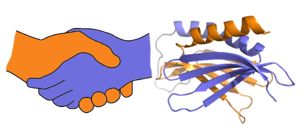User:Andrea Foote/Sandbox 1
From Proteopedia
(Difference between revisions)
| Line 6: | Line 6: | ||
== Structure == | == Structure == | ||
<scene name='78/786627/5fgo_repeatiii/2'>PUR repeat III</scene> facilitates dimerization of Purα monomers. The association of two repeat III domains forms what is termed the "intermolecular domain". | <scene name='78/786627/5fgo_repeatiii/2'>PUR repeat III</scene> facilitates dimerization of Purα monomers. The association of two repeat III domains forms what is termed the "intermolecular domain". | ||
| - | [[Image:180429 | + | [[Image:180429 proteopedia pura figures2.jpg|thumb|right|300px| A PUR domain is analogous to a left-handed handshake. PUR repeat I-II represented from 5fgp. |
]] | ]] | ||
== Function == | == Function == | ||
Revision as of 00:11, 30 April 2018
Purine-rich element binding protein alpha
| |||||||||||
Function
| |||||||||||
References
- ↑ Weber J, Bao H, Hartlmuller C, Wang Z, Windhager A, Janowski R, Madl T, Jin P, Niessing D. Structural basis of nucleic-acid recognition and double-strand unwinding by the essential neuronal protein Pur-alpha. Elife. 2016 Jan 8;5. pii: e11297. doi: 10.7554/eLife.11297. PMID:26744780 doi:http://dx.doi.org/10.7554/eLife.11297
- ↑ Hanson, R. M., Prilusky, J., Renjian, Z., Nakane, T. and Sussman, J. L. (2013), JSmol and the Next-Generation Web-Based Representation of 3D Molecular Structure as Applied to Proteopedia. Isr. J. Chem., 53:207-216. doi:http://dx.doi.org/10.1002/ijch.201300024

